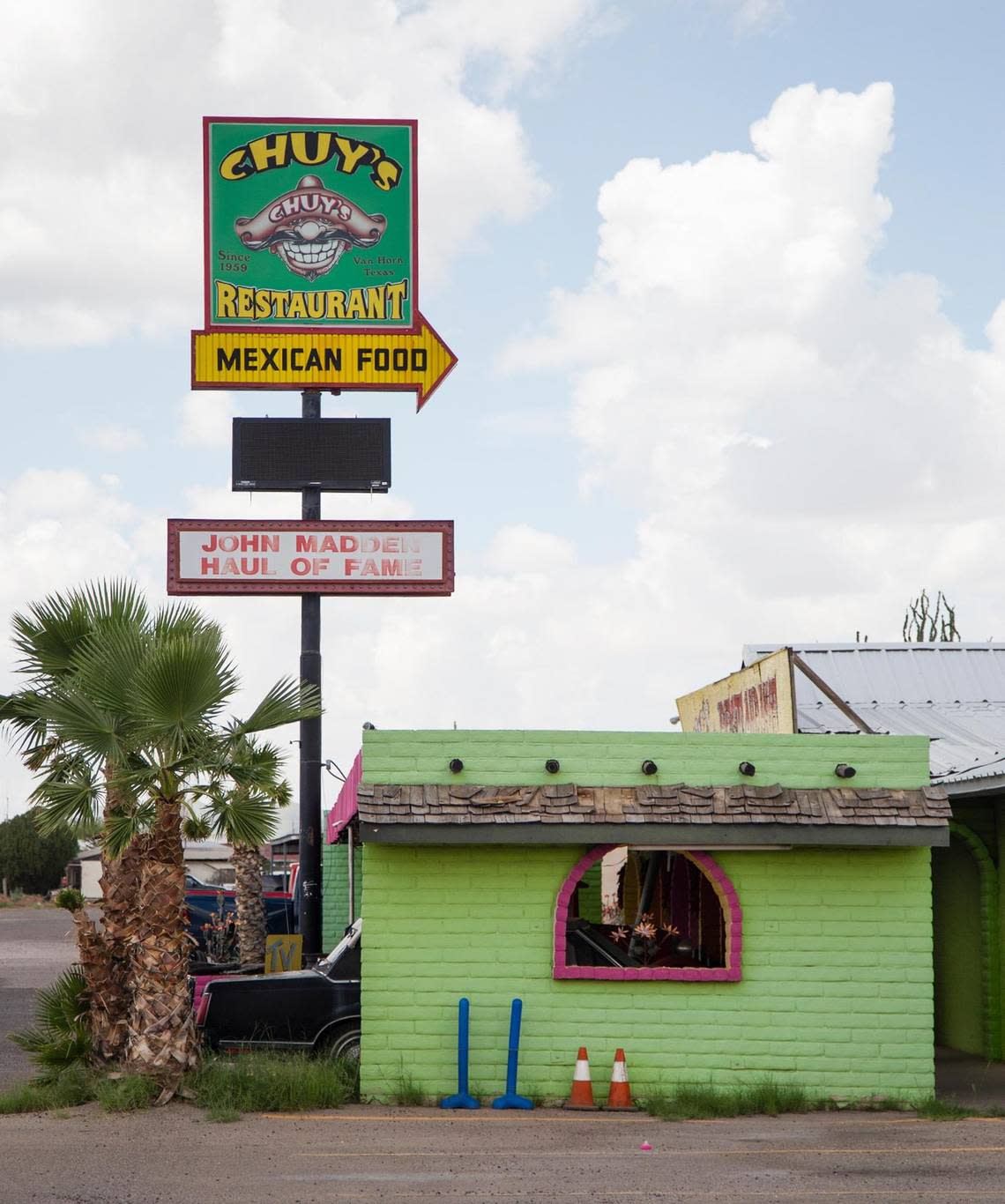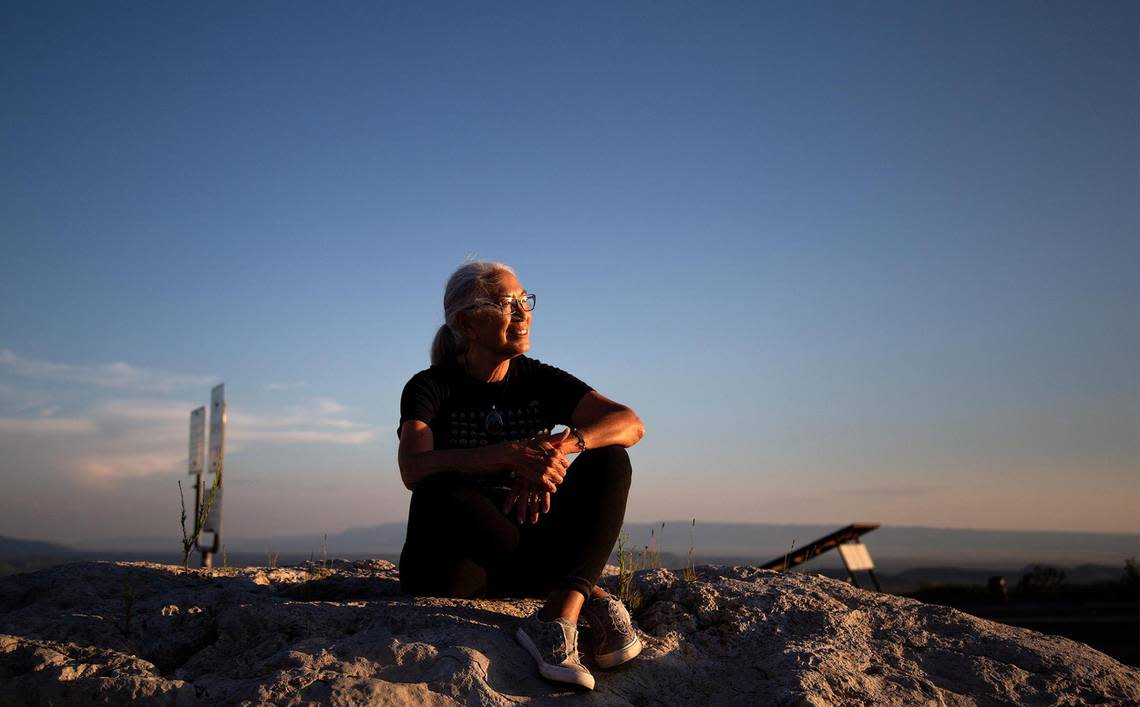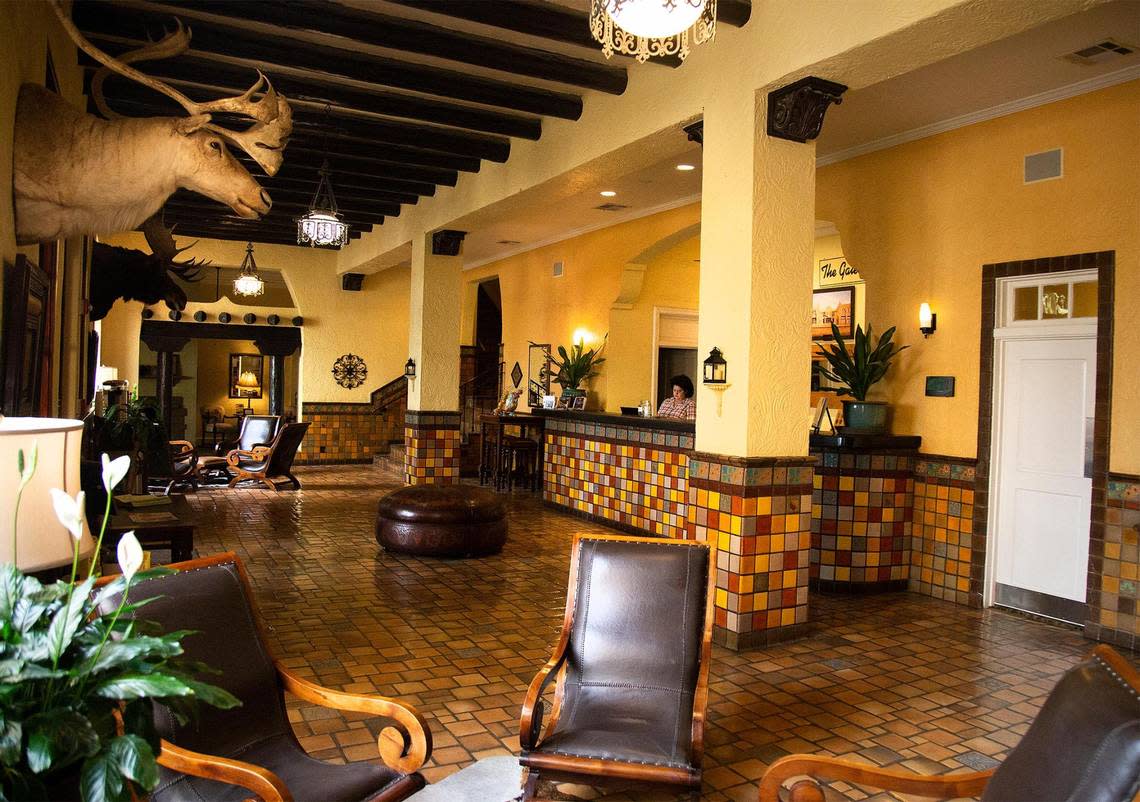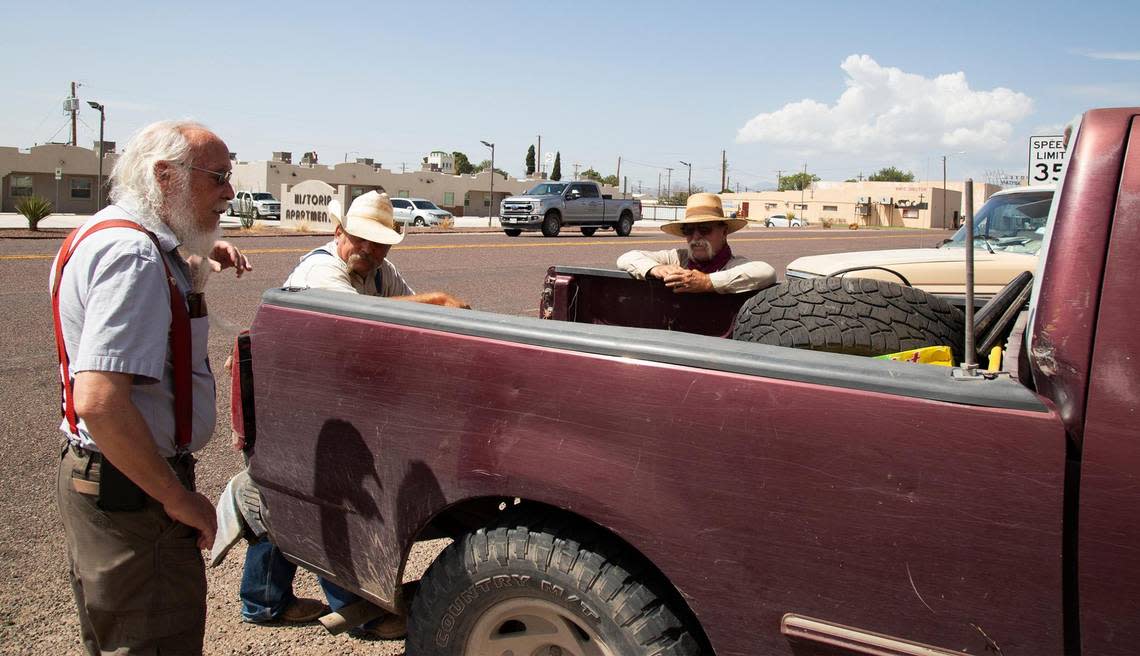One town, two frontiers: Inside tiny Van Horn, Texas — home to Jeff Bezos’ Blue Origin
Van Horn has never really been a household name for most Texans.
It’s about an eight-hour drive from Dallas-Fort Worth, past the wooded hills west of Abilene and the flatlands of the Permian Basin, where the earth stretches toward a boundless sky. There, in the foothills of far West Texas, you’ll come to Van Horn, a speck on the map no more than three square miles.
This frontier community of 1,893 people that was once a rest stop for mail carriers going between El Paso and San Antonio now plays host to a new kind of traveler jetting to a new frontier: space.
Jeff Bezos brought a media frenzy to the town when he picked a site less than 30 miles away for his Blue Origin rocket launches. But folks who call the town home say the engineers, space tourists and visitors who come to watch the rocket blasts haven’t changed Van Horn, where the streets are dusty, the buildings a testament to history and the people seemingly largely content with the lives they lead.
Since the first high-profile launches, Blue Origin’s presence has become more obvious on Broadway Street, with murals and banners lining the thoroughfare. The company completed its fifth human space flight on June 4, when six people took the 11-minute flight 62 miles above the earth.


And while the town has brought space travel enthusiasts through for the launches and become home to around 100 Blue Origin workers, residents and leaders in Van Horn aren’t sure what it means for the future.
They don’t know if — or for how long — they’ll be able to capture tourist business. They don’t expect to see much of the millionaires and billionaires who will soar into the great unknown because they can fly directly to the launch site. And the employees’ earnings could have negative effects on the town, which relies on grants to do things like fix roads and maintain waterworks because of its median household income of $34,853.
While the company has run operations in the foothills of the Guadalupe Mountains for years, many residents described it as secretive.
“Sort of clandestine,” as one resident put it.
The first launch in July 2021 made a mark in some of the businesses, like the restaurant at the historic Hotel El Capitan, where a stainless steel, 5-foot long Blue Origin feather hangs over the door to the hotel’s kitchen.
But if you ask the bartenders in the Hotel El Capitan’s restaurant or most anybody who lives here about Blue Origin, their simple reply will be, “Eh, it’s just kinda there.”
They’d rather talk to visitors about their town.
Welcome to Van Horn
Van Horn is home to waiters, ministers, academics, retired city folk and small business owners. This is where Joy Scott, an artist and retired teacher in her 70s, trains her dogs for urban mushing and tends to gardens surrounding sculptures welded by her late husband.

It’s where Lyndon McDonald, now a city council member, settled after decades as a parole officer, working with parolees across Culberson and El Paso counties. Van Horn is the lifelong home to Leticia Hernandez, a voice for education advancement as a member of the school board and an employee at the county library.
Broadway Street is lined with stores, restaurants and government offices. Other vacant buildings are reminders of the history Van Horn witnessed over nearly 200 years.

Paul Uranga’s Chuy’s Restaurant (an independent operation not connected to the Austin-based brand) is on Broadway, holding a shrine to the late football legend John Madden.
Madden made his mark on Van Horn when he stopped to watch a football game and eat a meal of chicken picado with rice, beans, sauteed veggies, onions, tomatoes and peppers in a light cheese sauce with a tortilla on the side.

That main thoroughfare is where Patricia Golden, director of the Clark Hotel Museum, spends her day studying the history of Van Horn as she strives simultaneously to gather, preserve and share stories of the town that would otherwise be lost to time. She’s reluctant to call herself a historian, but most will start to answer questions about the town’s past before they stop with a thoughtful look on their face and say, matter of factly, “If you really want to know the story, the real story, talk to Pat down at the museum.”
And almost everyone in town wants to talk about the natural beauty that surrounds it. Van Horn sits in a basin between Guadalupe Peak, Eagle Mountain, El Capitan and Mount Livermore. The sun beats down on the town almost every day, fading homes and the colorful advertisements on storefronts.
The mountains draw a dramatic backdrop and, at night, after the sun dips below the western peaks of the Eagle Mountain range, the sky is splattered with stars.
The desert
Desert plains and mountainous terrain have shaped Van Horn since 1845. Out here, in the unforgiving desert, life was treacherous in the early days. The environment wanted to kill you. So did outlaws and Native American raiding parties that swooped down from the mountains to attack the town or the stagecoaches that stopped there.
But, as Scott will tell you, it would be irresponsible to rely wholly on those outside the community. The right thing to do in Van Horn is to look out for each other and yourself. She grows her own fruits and vegetables in her backyard and is always willing to offer them to a neighbor in need. She knows she can rely on those neighbors, too.

The nature drew Golden, the museum director, to Van Horn. Born and raised in Coronado, California, Golden was traveling from Dallas to visit her hometown in the late 2000s when she first encountered Van Horn. It was barely a blink on the highway. A gas stop on the way somewhere else.
But the surrounding mountains intrigued her. She loves being outdoors and was determined to hike Guadalupe Peak, the highest point in Texas, on her next trip through the area.
Looking over the peaks and valleys of the Texas Mountain Trail, Golden had an epiphany standing there at the top of Texas: she didn’t want to leave. She decided she couldn’t live without the mountains and their lush vegetation and the desert painted in hues of copper, brown and tan.
So about 16 years ago, she packed up her things in Dallas and moved to Van Horn.
“It felt like freedom,” she says, sitting cross legged atop a boulder in the mountains, about a five minute drive from the entrance to the Guadalupe Peak hiking trail.

“It’s all freedom,” she says. “Not just the mountains but the actual town and the desert and all of it.”
She says you can be yourself here. If you need nightclubs and 49th-floor restaurants and shopping malls and movie theaters and theme parks, you might not see it the same way she does.
But, of course, Golden says the biggest freedom is the ability to wake up one morning and decide to go into the mountains or check out the salt flats. She could just as easily drive an hour south to Marfa, a community made up largely of artists and other creative types. Maybe make a stop at that funky “Marfa Prada” sculpture that looks (deceptively) like a genuine storefront just north of Valentine.
When Golden moved to Van Horn, she found a job teaching and started to volunteer at the Clark Hotel Museum.
Built in the 1800s, the Clark Hotel has served a lot of roles. For a short while, an upstairs room would play host to a courtroom with criminal trials by day and a ballroom with dances and parties by night. Now it’s the center of historical preservation. Age has brought a peculiar scent to this structure, a combination of aged wood, old metal, worn fabric and the stale, almost unnoticeable remnants of cigarette smoke. With no air conditioning, the interior buzzes as about a half dozen house fans work to circulate air in West Texas temperatures that are usually warm at their coolest and scorching at their hottest.
The building, like much of the town, has aged gracefully in an environment where things, if they aren’t maintained, are slowly but inevitably reclaimed by the desert. The hotel’s sturdy floors show wear and the walls have discolored, but the building hasn’t been neglected by any measure.
Golden will tell you bluntly that she couldn’t see herself more fulfilled working anywhere else. Her face lights up if someone asks her to share what she knows.
She has plenty of stories to share, some verified and others oral histories that could just as easily be rumors. The tales of the town’s foundation as a watering stop for postmen and stagecoach drivers are verified, as are the accounts of skirmishes with nearby Native American tribes in the town’s early days.
The story of the county judge who fatally shot the sheriff in the back because the sheriff was trying to save the life of another man shot by the judge is less verifiable. But verified or not, those tales have played roles in the way residents understand and remember Van Horn’s history. That understanding affects the culture and shapes the people living here.
Van Horn lived through the Wild West. A sign hangs in the Clark Hotel Museum, boldly sharing a statement some say dates to the time before the town had a cemetery and others say was a fabrication at some point in the 1900s meant to add excitement to the town’s perception of itself: “This town is so healthy we had to shoot a man to start a cemetery.” And while Van Horn is no longer a lawless land of dueling cowboys and sheriff-shooting judges, it hasn’t let that spirit of perseverance and self-reliance go entirely.
Sheriff Oscar Carillo and his deputies work to make sure this isn’t still the Wild West. Oscar, a mild man with a desert-worn face and short cropped hair usually hidden behind a white cowboy hat discolored from wear, will sit down and have a friendly conversation with just about anybody. His confident, authoritative voice carries a softness that is hard to place.
Carillo will tell you his biggest struggle is often just reminding people to lock their house and car doors. It’s not a dangerous place to live, but a lot of the people in town are just passing through, and you can’t ever know their true intentions. Better to be safe.
Outside of Van Horn, things look a bit different. Carillo spends hours a day around in his newer model pickup, keeping an eye on things in town. But he’s also occupied in the rest of the county with the migrant crisis at the border. People crossing the Texas-Mexico border illegally often find themselves in the desert in his county, he says. And while the last year or so brought inordinate amounts of rainfall to the region, getting stuck in the desert is still often a death sentence, brought by dehydration or heat. Because of that crisis, the town’s gotten used to Border Patrol agents and Texas State Troopers living in and moving through Van Horn.
Changing Van Horn
Ask around town and just about everybody will tell you about a different way in which Van Horn has changed. Oscar will tell you about how the undocumented migrant crisis in the region has changed the population of the town to include more Texas State Troopers and Border Patrol agents. Former Mayor Becky Brewster will talk about aging waterworks and roads and how the presence of Blue Origin employees has increased median incomes and made it harder to find grants to fix problems. Vance Cottrell, owner of the Napa Auto Parts and an alfalfa farmer, remembers cars cruising the now quiet Broadway Street in the 1980s and seeing the sheriff on the side of the road wagging his finger at kids driving too fast, a warning to head home or get a ticket. You’d just get the ticket today, he says.
Many will recall the town’s heyday in the 1970s, even if they weren’t born yet to experience it themselves. The population was more than 3,000 people and the downtown storefronts were almost all occupied. The town had things like a drive-in movie theater, guided tours of Red Rock Ranch and a car dealership.
Superintendent Ken Baugh of the Culberson County-Allamoore school district, really just a single campus in town for kids from preschool to 12th grade, said he wants to see another boom, and hopes the early college high school program he has started will help do that. Some can work for Blue Origin if they go through the school’s early college program. Beyond that, though, Ken hopes to see students stay in town and put their associate’s degrees to work in expanding the economy.
Some he hopes will stay in Van Horn and use their degrees to start or help expand existing businesses. Others he hopes will continue their higher education then come back to town.
The biggest focuses for the program are in nursing, welding and electrical work. Baugh said Van Horn could grow and see more economic prosperity if the early college program (a partnership with Odessa College) is given the time and support it needs to succeed.
He is practically giddy as he strides into the labs where students get hands-on experience with electrical work and welding.
“This is really the future,” he says. He has a gruff voice and talks fast with a little bit of an old West Texas drawl. “This is how we help our students have better lives than their parents, and their children have better lives than they do. That’s one of the biggest goals in the end, isn’t it?”
That doesn’t mean every student will use a degree or certificate if they get it. Some, like David Ortiz, are happiest staying in town and working in one of the existing businesses, usually in the service industry. Ortiz, who plays with his Mexican folk band in Van Horn and other “nearby” small towns, said his schedule at Breakfast on Broadway Cafe, one of Van Horn’s newer establishments, allows him to make time for the performances. And life doesn’t cost a lot here, anyway.
Concern about finances
Money isn’t normally a problem for most people in Van Horn. But for the city itself, funding is gradually becoming more troublesome.
Brewster, the former mayor, has become an expert in pursuing grants that can help the city meet the needs of its residents. She takes an immeasurable amount of pride in Van Horn. She’s not a native, but her husband is. She adopted his love for the town when she moved here, she says as she sits in the dining room of Lizy Tortilla’s on the north side of town, eating a big steak burrito and wearing a controversial purple shirt.
“A lot of people aren’t too happy when they see me wear purple,” she says between bites. Her favorite color is purple. For many in the town, that’s their least favorite. “Everybody says, ‘Becky, you’re the mayor and you should be wearing red.’ Because our school color is red, and the school color in Marfa is purple.”
But the color of her shirt isn’t Brewster’s biggest concern right now. Her biggest concern is money in the city’s coffers. About 40% of Blue Origin employees claim Van Horn as home. That makes up about 100 people in town, and they are usually higher earners than most who live there.
She fears the median income of Van Horn will increase to the point the city won’t qualify for grants, like the $2.5 million one the city has applied for to improve water pressure.
That grant would allow the city to fix those problems and subsequently open the door to three big hotels and other businesses she said expressed interest in coming to town. That would give Van Horn more property, sales and tourism tax income that could help combat the money woes she fears in the near future. It would bring some employees into the town and hire others who are already living there. That means more money all around, she says.
Something as simple as fixing the water could, at least in theory, lead to a small economic boom many thought they might see with Blue Origin but for which they are losing hope. McDonald, the city council member, said most people will just fly to the launch site. Blue Origin, for its part, has stayed mum on the way its operations could affect the town and its economy in the future.
Brewster moved to Van Horn during its heyday. The town had clothing stores, auto dealers, a furniture shop, tours of Red Rock Ranch and a fabric store.
“It was practically the big city. Just practically,” she deadpans before she takes a sip of water, which both she and Golden describe as the best in all of Texas. She thought that was life in Van Horn at first, but quickly realized it wasn’t the norm. People moved away and ranches started to disappear. Those who stayed haven’t lost pride in their home, but they will tell you it’s not as bustling a place to live as it once was.
Some, like contractor Jeff McCoy, say less reliance on grants could be a good thing for the town. He went to college in El Paso, lived in other cities and saw the outside world but came back. He wishes more could do the same.
As he stands on the roof of the Hotel El Capitan, where he is working to refurbish parts of the historic building, he points to a parking lot across Van Horn Street, outside a hardware store and the Culberson County Financial Center. The parking lot he points to, while simple, seems oddly elaborate. Fancy street lights are paired with shrubs and decorative rocks and backed by a Van Horn postcard mural to frame a smoothly paved place to leave your car.
‘Oasis in the desert’
Not that everything needs to be new or innovative. Hotel El Capitan is one of the most notable examples of that. Built in 1930, it looks like a small Spanish mission. Its antique, red neon sign atop the building advertises it as a place drivers can find rest when their eyes grow weary. Stepping into the “oasis in the desert,” as the hotel’s owners describe it, is like taking a step back in time.
Its 49 rooms, 12 of which have French doors leading to private Juliette balconies offering views of the mountains and plains that surround it, have the modern amenities travelers expect. But there’s still a sense of time travel when you step through the arches at the front of the hotel into the courtyard.

Trees tower overhead and lush, carefully manicured plants surround the walkways. A fountain in the center pumps a constant flow of precious desert water. Diners at The Gopher Hole can sit at tables in the courtyard. It’s one of the few places locals might regularly mingle with the Blue Origin employees, who the residents often see as introverted.
Starvanna Cottrell is in charge of managing the historic site. She’s another of the Van Horn natives who left town for college and found her way back. Cottrell smiles talking about how Blue Origin’s launches bring more people to the town and add a little extra excitement to her job.

Van Horn has been home to four generations of her family now. Her dad, Vance, owns Napa Auto Parts and her grandparents, Larry and Dawn Simpson, used to own the newspaper, The Van Horn Advocate.
The hotel was built in the 1930s and started to decline in the 1970s, when Interstate 10 opened and travelers began to bypass the town. It eventually closed and became a bank before it was restored in 2007.
To Golden, the Hotel El Capitan is like the Clark Hotel Museum: a living example of the town’s past. Its architecture speaks to the past — the red neon sign, the interior design — while the managers incorporate local products like pecans to share the town’s voice today.
Golden says the hotel is an example of how Van Horn will always be a place people can call home, whether Blue Origin brings an economic and population boom or the city continues its cycle of growing and shrinking.
Residents say there is something intangible in the culture and spirit of Van Horn. Something that can be described, but not quite defined.

Some, like Golden, will say it’s rooted in the history and the nature that surrounds it. Hernandez, the school board member and library employee, will say it’s family and community. McDonald, the city council member, will say the isolation and the desert makes it easier, even necessary, for everyone to share in the experiences requisite to create that community.
While Van Horn is small and largely isolated from the rest of the world, one thing is for certain: leaving this town is a lonely experience. Friendships here are built fast and built to last. As the sun sets to the west, casting those otherworldly colors across the sky in the rearview mirror as visitors head back home to the Metroplex, there’s a reluctance to drive on.
And, just like the desert and the mountains and the tumbleweeds, Van Horn doesn’t seem to be going anywhere. It’ll live on as a reminder of Texas’ history and an example of what people can do to make an inhospitable environment into a home. Of how a culture can be formed around that nature, and how a community can evolve with time without losing sight of its history.
